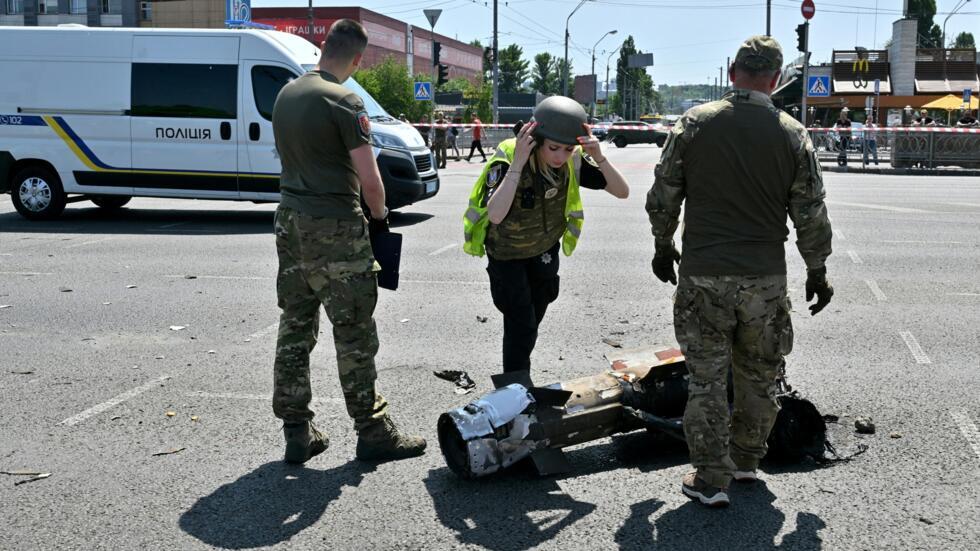Ukraine Discovers Debris from Russia’s Newly Deployed Ballistic Missile
Investigators in Ukraine are currently analyzing remnants of an intermediate-range ballistic missile (IRBM) used by Russia in a recent attack on the city of Dnipro. This incident marks the first confirmed deployment of this type of missile in a combat scenario, giving military analysts and security officials keen insight into the evolving battlefield dynamics in the region.
Details of the Attack
On Thursday, as tensions continued to rise in the ongoing conflict, the missile, dubbed Oreshnik—translated as “Hazel Tree” in Russian—struck a factory in Dnipro, leading to substantial destruction. During a national address, Russian President Vladimir Putin confirmed the strike, framing it as a direct reaction to the U.S. and U.K. approval for Ukraine to utilize Western-supplied long-range munitions against Russian targets. As Putin emphasized, such measures are deemed necessary to counter Western support for Ukraine’s military initiatives.
Missile Wreckage Analysis
The unique features of the missile have sparked considerable interest among military analysts. Ukraine’s Security Service unveiled fragments of the Oreshnik missile to The Associated Press (AP) on Sunday. The wreckage includes photos depicting burnt wires and a portion of the missile’s airframe, which has been likened to the size of a large snow tire. Notably, this missile possesses the capability to carry either nuclear or conventional warheads.
“This is the first documented discovery of such a missile in Ukraine,” stated an unnamed specialist from Ukraine’s Security Service, identified only as Oleh to maintain confidentiality regarding sensitive information. As investigations continue, security officials are striving to confirm the design specifics and operational capabilities of the missile, which some suggest is based on Russia’s RS-26 Rubezh intercontinental ballistic missile (ICBM).
Launch Information and Flight Details
Further insights emerged from Ukraine’s Main Intelligence Directorate, revealing that the missile was launched from Russia’s Kapustin Yar missile test range in the Astrakhan region. Reports indicate that the missile was airborne for approximately 15 minutes before reaching its intended target in Dnipro. Notably, this missile is reportedly capable of carrying six warheads, each affixed with six submunitions, and it attained remarkable speeds during its flight, recorded at Mach 11.
U.S. Informed of Missile Launch
In a related development, Deputy Pentagon Press Secretary Sabrina Singh confirmed news of the Russian missile launch during a press briefing last week. Describing the Oreshnik as a “new type of lethal capability,” she highlighted the importance of this development in the context of the ongoing conflict. Singh also disclosed that the U.S. received alerts concerning the missile launch through established nuclear risk-reduction channels shortly before the missile was deployed.
President Putin asserted that the missile struck its target at a speed of Mach 10; however, some U.S. defense officials disputed this claim, stating it did not meet the criteria necessary to classify it as a hypersonic weapon. According to criteria set by NASA, a hypersonic weapon must exceed a speed of Mach 5, or approximately 3,000 mph, raising questions about the capabilities being showcased by Russia.
Military Recruitment Initiatives in Russia
In addition to unveiling the missile, Russia announced new measures aimed at boosting military recruitment amid its ongoing engagement in Ukraine. President Putin has signed legislation that allows for debt forgiveness for individuals who join the Russian military. According to reports from The Associated Press, this legislation signals Russia’s pressing need for personnel as the conflict persists.
Under the newly enacted law, individuals who sign one-year military contracts can have debts of up to 10 million rubles (approximately ,000) canceled. This incentive extends to the recruits’ spouses and even includes debts that are subject to court-ordered collection, provided the legal proceedings began before December 1, 2024. Such measures underline the ongoing transformation of the Russian military’s operational approach amidst escalating hostilities.
Implications for Ongoing Conflict
The deployment of the Oreshnik missile and accompanying recruitment incentives reflect the increasing scale and intensity of the conflict as both Ukraine and Russia brace for prolonged warfare. Analysts predict that as both sides adapt to evolving military capabilities and strategies, the challenges faced in this protracted conflict will continue to escalate, making it imperative for both nations to wield their resources judiciously.
The unprecedented use of advanced weaponry in this conflict raises further concerns about the potential for increased destruction and civilian casualties, as both countries navigate this treacherous landscape. As Ukraine investigates the implications of the Oreshnik missile deployment, it faces the dual challenge of reinforcing its defenses while seeking to counteract the escalating threats posed by Russian military advancements.
*With contributions from The Associated Press.*
